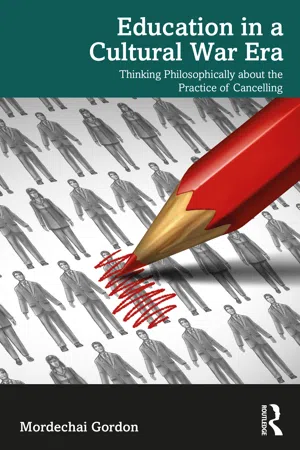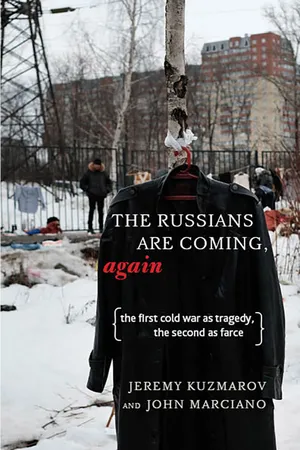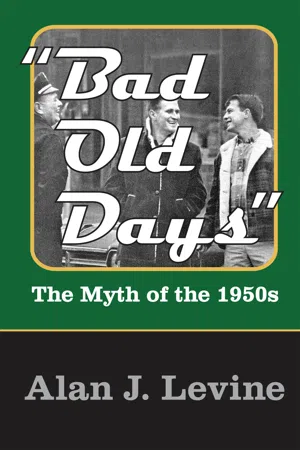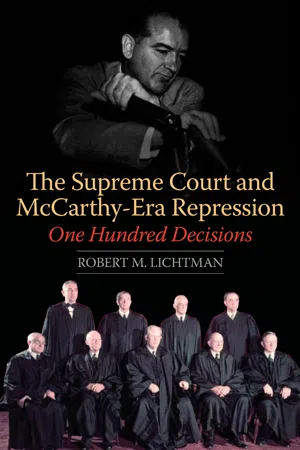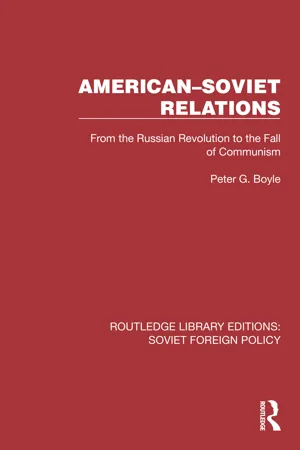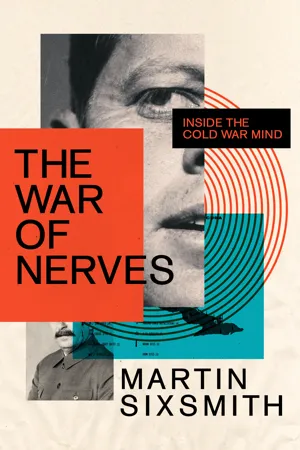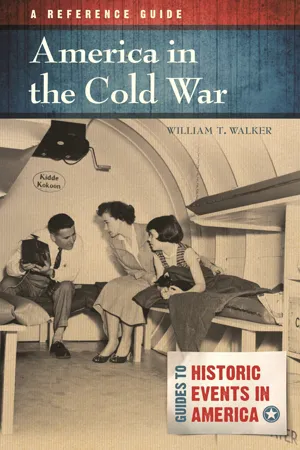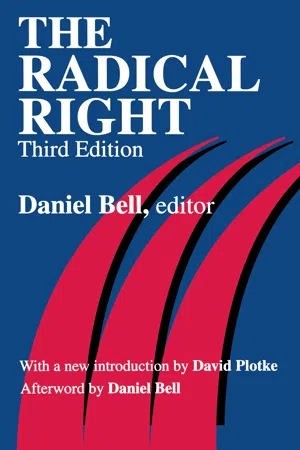History
McCarthyism
McCarthyism refers to the anti-communist pursuits led by Senator Joseph McCarthy in the United States during the early 1950s. It involved the use of unfounded accusations, blacklisting, and the suppression of political dissent, particularly targeting individuals suspected of communist sympathies. The era was marked by widespread fear and paranoia, and had a significant impact on American society and politics.
Written by Perlego with AI-assistance
Related key terms
Related key terms
1 of 4
Related key terms
1 of 3
12 Key excerpts on "McCarthyism"
- eBook - ePub
The Cold War at Home
The Red Scare in Pennsylvania, 1945-1960
- Philip Jenkins(Author)
- 2014(Publication Date)
- The University of North Carolina Press(Publisher)
Specifically, it is a useful comment on what has come to be known as McCarthyism, a word that is often used in a far broader sense than it deserves. The term has come to be synonymous with the official movement to seek out and remove Communists from American life, a theme that became a national phenomenon in 1947 and remained in vogue at least through the mid-1950s. Accurately reflecting popular usage, Ellen Schrecker writes of “McCarthyism, the anti-Communist political repression of the late 1940s and 1950s,” while Albert Fried’s book on McCarthyism is subtitled The Great American Red Scare. 2 Governor Duff’s views suggest a problem with this approach: while he yielded to nobody in his anti-Communist zeal, he was categorically not a McCarthyite in the sense in which that word was used in his day. For Duff, as for many of his contemporaries who would have described themselves as liberals, McCarthyism was an unacceptable form of extremism. It was an irresponsible and dangerous tactic characterized by vague and unsubstantiated accusations for political ends, the exploitation of hysterical public fears, the reckless persecution of innocent or relatively harmless dissidents, and the practice of using loose connections between suspected individuals in order to construct “a conspiracy so immense.” Critics used the term essentially synonymously with witch-hunting or demagoguery, and, as such, it deserved utter repudiation. Worse, it distracted public attention from the urgent need to discover authentic Communists, who should at the least be removed from any office of trust. McCarthyism did not, in these years, refer to the use of quite intrusive or inquisitorial means to discover and root out genuine Communists or subversives, potential spies and saboteurs, a process that had sustained the support of a broad bipartisan consensus for several years before Senator McCarthy himself became a figure of national consequence - eBook - ePub
Education in a Cultural War Era
Thinking Philosophically about the Practice of Cancelling
- Mordechai Gordon(Author)
- 2022(Publication Date)
- Routledge(Publisher)
3CANCELLING DURING THE McCARTHY ERADOI: 10.4324/9781003214984-4Introduction
Many Americans have heard of the term McCarthyism and are aware of this dark period in the history of the United States post-World War II that involved an attempt by the government to combat the red menace and prosecute communists and other leftist leaders. Yet, the information that Americans generally get about the McCarthy era (1946–1954) tends to be surface level and consists of only one aspect of this somber period—the hearings led by the Wisconsin Senator Joseph McCarthy that were aimed at outing, blacklisting, and punishing Communist leaders and groups. Missing from most Americans’ understanding of the McCarthy era is an awareness of the bigger picture, a sense of the various factors that converged to shape what scholars have called “the great American Red Scare” (e.g., Fried, 1997; Steinberg, 1984).This chapter seeks to provide readers with a sense of the bigger picture, that is, an appreciation of those political, social, and legal dynamics that played a role in the persecution and cancelling of Communist leaders and other citizens in the United States post-World War II. In particular, I outline four factors that need to be taken into account if we are to adequately make sense of this grim period of American history: the Truman Loyalty Program and his administration’s efforts to curtail the left; various laws like the Smith Act and the Internal Security Act that were designed to restrict the freedoms of those who opposed the government of the United States; the hearings organized by McCarthy and other Congressional committees to target Communist groups and individuals; and finally, the role that J. Edgar Hoover and the FBI played in the surveillance and punishment of American Communists. Following the analysis of these key factors, I examine a couple of case studies of individuals persecuted during the McCarthy era in order to personalize the consequences faced by actual people. I conclude this chapter by reflecting on the legal and political legacy of the McCarthy era, a legacy that negatively impacted the United States for years thereafter. - eBook - ePub
The Russians Are Coming, Again
The First Cold War as Tragedy, the Second as Farce
- Jeremy Kuzmarov, John Marciano(Authors)
- 2018(Publication Date)
- Monthly Review Press(Publisher)
The anti-Communist hysteria of the 1940s and 1950s also resulted in the jailing and deportation of radicals, while contributing to the decimation of organized labor and a rightward shift in the political culture. The GOP spearheaded the witch-hunting climate as part of an electoral strategy designed to break the Democratic Party’s dominance during the FDR New Deal–Truman Fair Deal era. Liberal Democrats weakened themselves by acquiescing to McCarthyism and would never reclaim the progressive spirit seen under Roosevelt. 4 One could draw a direct line from the red-baiting days of the Cold War to the Russia-Gate witch hunt, which draws on the worst of U.S. political traditions. “M ANY ARE THE C RIMES”: T HE C OLD W AR R ED S CARE The term McCarthyism derives from the anti-Communist crusading of Senator Joseph McCarthy (R-WI), who catapulted himself to national prominence after giving a speech in Wheeling, West Virginia, in February 1950, claiming without any evidence that there were 205 card-carrying members of the Communist Party working in the U.S. State Department. The anti-Communist fervor gripping the United States would transcend the political career of McCarthy, who was personally discredited after extending his accusations to the U.S. Army and appearing as a bully on national television. 5 Historians have explained McCarthyism as a form of populism gone sour that was associated with the status anxiety of certain ethnic groups—like the Irish, Eastern-European-born Catholics, and Germans—xenophobia, and a kind of anti-intellectualism of the frontier. Other studies have shown, however, that Senator McCarthy was supported by wealthy business interests, who saw in the Red Scare an opportunity to help roll back New Deal reforms benefitting the working class by equating left-wing views with Communism. From 1946 to 1948, the U.S - eBook - ePub
Bad Old Days
The Myth of the 1950s
- Alan J. Levine(Author)
- 2017(Publication Date)
- Routledge(Publisher)
In the 1950s and 1960s, opponents of McCarthyism defined it as the wave of false, or at least wholly irresponsible, charges of Communism and espionage made by Senator McCarthy and such imitators as William Jenner, Harold Velde, and perhaps, the more cautious, or cleverer, Richard Nixon, that attracted public attention from roughly 1950-1954. No one, or at least no one taken seriously even by liberals, suggested in the 1950s that it was not legitimate to keep Communists out of sensitive posts, or that there were no Soviet spies in the United States; McCarthyism was a particular sort of extremism. The present writer has no problem with this traditional understanding of McCarthyism.Unfortunately, that is not the only one around. Since the late 1960s, conceptions of McCarthyism have been so altered or embroidered that many bear little resemblance to that of the contemporary critics; in fact they sometimes invert it. Thanks to revisionist historians of the Cold War, such as Richard Freeland and Athan Theoharis, a sort of snowballing definition of McCarthyism began to develop. The first step was associating virtually any concern whatever with internal security or Soviet espionage with McCarthyism—so that President Truman and his administration, Joe McCarthy’s chief target, could be bracketed with McCarthyism and blamed for it. Many went further, and proceeded to pretend that all those convicted in the spy cases of the late 1940s and early 1950s—especially Alger Hiss and the Rosenbergs—were the innocent victims of frame-ups. The next step was to treat practically any opposition to Communism as a manifestation of McCarthyism—a stance strongly advocated by Ellen Schrecker, the best-known contemporary academic authority on McCarthyism. This tendency reached an extreme in David Caute’s well-known book, The Great Fear , and ended in a curious inversion. To Caute and similar people, the real villains were the Truman administration and anti-Communists in general; to them, McCarthy was not so bad, because his antics actually helped discredit the anti-Communist side. As a later critic sourly observed, by the 1970s, on the further left, to call a Communist - eBook - ePub
The Supreme Court and McCarthy-Era Repression
One Hundred Decisions
- Robert M. Lichtman(Author)
- 2012(Publication Date)
- University of Illinois Press(Publisher)
1Defining the McCarthy Era
The more remarkable aspect of the McCarthy era is not that political repression occurred but that its duration and scope were so broad. A combination of circumstances and events following World War II, international and domestic, quite predictably held the seeds of repression:- With the glow of America’s victory still fresh and a period of peace and normality in prospect, the Soviet Union, a valued ally in the war, abruptly became a dangerous antagonist, forging a bloc of satellite Communist nations and seeking aggressively to expand its influence throughout the world.1
- The confrontation was not only military and economic but also overtly ideological. Soviet Communism proclaimed itself the wave of the future that would engulf and replace American capitalism.
- In the United States there existed a history of hostility to foreign ideologies and Communism in particular (for example, the post–World War I “Red Scare”), along with a visible and outspoken American Communist Party (CPUSA), which endorsed virtually every twist and turn of Soviet policy.2
- In the summer of 1948, public concern over Soviet espionage utilizing American Communists was triggered by the testimony of ex-Communist Elizabeth Bentley that she served, until her defection in 1945, as a courier for Soviet spy rings composed largely of American Communists employed in federal agencies. Her testimony was buttressed by that of another ex-Communist, Whittaker Chambers. The individuals they accused included Alger Hiss, a former State Department official who accompanied FDR to Yalta.3
- eBook - ePub
American–Soviet Relations
From the Russian Revolution to the Fall of Communism
- Peter G. Boyle(Author)
- 2022(Publication Date)
- Routledge(Publisher)
8 The Red Scare and Mc Carthyism On 9 February 1950 Senator Joseph McCarthy said in a speech in Wheeling, West Virginia, thatWhile I cannot take the time to name all the men in the State Department who have been named as members of the Communist party and members of a spy ring, I have here in my hand a list of 205 that were known to the Secretary of State as being members of the Communist party and who, nevertheless, are still working and shaping policy in the State Department.1McCarthy’s astounding charge triggered off four years of national hysteria which had been building up since 1945 and which reached its climax in the phenomenon of McCarthyism from 1950 until McCarthy’s condemnation by the Senate in December 1954.The Red Scare arose partly from rational concerns over Soviet expansionist ambitions and possible infiltration into the US government of American Communists whose ideological allegiance to the Soviet Union was stronger than their national loyalty to the United States. To a much greater extent, however, McCarthyism arose from irrational and emotional factors within American society in the late 1940s and early 1950s. McCarthy’s charge that there were 205 members of the Communist Party employed by the State Department in 1950 provided a vivid example of the irrationality of McCarthyism. McCarthy’s accusation, when considered in a literal sense, was staggering. Its absurdity in a literal sense was easily demonstrable, but this missed the deeper significance of McCarthy’s accusations. McCarthy had hit a responsive chord in the fears, anxieties, suspicions, frustrations and other such emotional concerns of Americans of the time. An analysis of these emotional responses of the American people during the Red Scare reveals significant aspects of American attitudes towards Communism which played an important role in shaping American policy towards the Soviet Union. - eBook - ePub
The Cold War Comes to Main Street
America in 1950
- Lisle A. Rose(Author)
- 1999(Publication Date)
- University Press of Kansas(Publisher)
Both men had been sympathetic to young foreign service officers in Chongqing, who in 1944 and 1945 had insisted that Mao and his communist followers should be considered the true voices of China. 12 In the context of the Hiss and Fuchs affairs, Lucas, like Peurifoy, could no longer ignore McCarthy’s claims, however wild and unsubstantiated they might have seemed. Two days after McCarthy’s marathon performance on the Senate floor, Lucas received permission from the Democratic congressional conference to propose a resolution authorizing a subcommittee of the Senate Foreign Relations Committee to look into McCarthy’s indictments. It passed unanimously. Shortly thereafter, Herbert Block, the renowned political cartoonist of the Washington Post, coined the word “McCarthyism.” The term was meant to be condemnatory; McCarthy shrewdly exploited it as a movement. 13 And a movement it swiftly became. For more than forty years, scholars and journalists have argued about whether McCarthyism was rooted deep in the American past or was simply a spasmodic response to postwar frustrations. Was it a broad movement of social protest or merely a reaction by angry Republicans to repeated defeats and embarrassments? 14 McCarthyism remains elusive because its critics have concentrated on the man and have extrapolated the movement from what he said and what he did. Political scientist Willmoore Kendall wrote in 1963 that “the issue was Joe McCarthy himself.” Thirty-two years later, another political scientist, David H. Bennett, insisted that McCarthyism “could not endure” beyond McCarthy himself and the immediate postwar conditions that made him. Once Eisenhower fashioned a new, more moderate political culture in 1954, McCarthyism lost its rationale and drive. 15 But Kendall and Bennett are wrong. McCarthy was not a lone political vigilante as he is often depicted; he was not a shoot-out artist who single-handedly blazed away at the liberal establishment - eBook - ePub
The War of Nerves
Inside the Cold War Mind
- Martin Sixsmith(Author)
- 2021(Publication Date)
- Wellcome Collection(Publisher)
For an America struggling to define itself, McCarthy’s simplistic prescription – that we define ourselves by opposition to the ‘other’ of Soviet communism – had a seductive appeal. His explanation for America’s woes – that they are the work of the hostile ‘other’ – was reminiscent of Stalin’s policy of exculpating the nation for its own failings by ramping up a unifying hostility to an external bogeyman. The witch-hunt was a staple of Soviet life, where saboteurs and wreckers were always to blame; in the US, the role would be taken by Reds under the bed.McCarthyism nurtured moral panic. The sociologist Howard Becker described him as a ‘moral entrepreneur’, raising the spectre of ‘deviant’ subcultures in order to persuade others to join his crusade, to create new societal rules and to promote themselves in the process.27 McCarthy, said Richard Hofstadter, was ‘an old and recurrent phenomenon in our public life’, the paranoid conspiracy theorist who spreads fear and panic to gain notoriety.28As the months passed and the initial impact of his ‘revelations’ threatened to diminish, McCarthy redoubled his accusations and turned up the volume of his rhetoric. A year on from his West Virginia debut, he had moved from talk of communist sympathisers in the bureaucracy to claims of a sinister cabal of politicians at the very top of the government, deliberately plotting the downfall of their own country.How can we account for our present situation unless we believe that men high in this government are concerting to deliver us to disaster? This must be the product of a great conspiracy on a scale so immense as to dwarf any previous such venture in the history of man. A conspiracy of infamy so black that, when it is finally exposed, its principals shall be forever deserving of the maledictions of all honest men … What can be made of this unbroken series of decisions and acts contributing to the strategy of defeat? They cannot be attributed to incompetence.29There was no room for nuance in McCarthy’s view of the world. He saw himself as the - eBook - ePub
America in the Cold War
A Reference Guide
- William T. Walker(Author)
- 2014(Publication Date)
- ABC-CLIO(Publisher)
Chapter 3
McCarthyism, Eisenhower, Kennedy, and the Culture of the Cold War
The decade of the 1950s began with the emergence of Senator Joseph McCarthy as a strident and reckless anticommunist, the formalization of American Cold War policy in the top secret National Security Council (NSC) Report 68, the outbreak of the Korean War, and American society and culture continuing to adapt to a new reality—the ongoing Cold War with the Soviet Union and living in the nuclear age. The decade witnessed the conviction and execution of spies Julius and Ethel Rosenberg; two successful campaigns for the presidency by Dwight D. Eisenhower; the death of Stalin and the rise of Khrushchev; the rapid expansion of the American economy and the Soviet Union’s slow recovery from the ravages of World War II; demands for civil rights for African Americans; demonstrations for political, economic, and civil liberties in Poland, Czechoslovakia, and Hungary; American supported coup d’états in Iran and Guatemala; a developing crisis in Southeast Asia (Indo-China/Vietnam); the development of ballistic missile technologies by the Soviet Union and the United States; and revolution in Cuba.With the Soviet success in detonating an atomic bomb, the fall of China to communists, and the establishment of NATO, President Truman on January 31, 1950, directed that the National Security Council establish a study group consisting of State and Defense Department leaders along with others appointed by Truman to review the challenges that confronted the United States and to develop a comprehensive strategy. The study group was formed immediately and was headed by Paul Nitze. It submitted its report to the NSC (NSC-68; see Document 7 ) on April 7, and the NSC sent it to Truman on April 14. While it was based on George Kennan’s policy of containment, NSC-68 focused more on American military capabilities than diplomacy. It argued that what was a stake in the Cold War was the survival of the United States and Western civilization, that it could become necessary to triple defense expenditures, and that initial outlays could require extensive funding. Fundamentally, NSC-68 recommended a strategy that would both defend the United States and its allies and defeat the Soviet Union in the event of war. Truman did not accept NSC-68 when it was presented—he wanted more specifics and feared the economic impact of financing it. Some of Truman’s advisers thought that implementing NSC-68 would escalate the Cold War and aggravate the already poor relationship with the Soviet Union. The debate on NSC-68 evaporated with the outbreak of the Korean War in June 1950. Truman signed NCS-68 on September 30, 1950, but demanded additional budgetary reviews through 1951. NSC-68 remained a guiding document in American Cold War strategy for a generation.1 - eBook - ePub
- John Callaghan, Brendon O'Connor, Mark Phythian(Authors)
- 2019(Publication Date)
- Routledge(Publisher)
15 For the voters in the 1952 presidential election it was foreign policy – not domestic subversion – that was the salient issue concerning communism; the more concerned the voter was about foreign policy the more likely they were to support the Republicans. The stress of McCarthy and his most prominent supporters on internal subversion had little popular resonance at this point. It was the Korean War that now mattered to the public. But the political elite only turned against McCarthy when he began to attack a Republican administration and such bastions of the establishment as the army, the Senate and General George Marshall. By this time popular fears over foreign policy had been allayed by the truce in Korea.When the elite turned against McCarthy he was effectively finished.16 But ‘McCarthyism’ survived the Senator’s demise in important ways. Much of the radical left had been demobilised, dispersed and demoralised by the anti-communist campaigns of the decade after 1944, its organisations wound up and its campaigning issues discredited or forgotten.17 The anti-communist flood had assisted the passage and acceptance of the Taft-Hartley Act of 1947, which permanently weakened the unions. Anti-communism strengthened the defenders of the racial status quo in the South in the 1950s and helped to preserve the region from labour organisations.18 The left was destroyed and fear also silenced liberal critics of the anti-communist consensus. The State Department was purged of many of its East Asia experts. Those who survived the witch-hunt tended to conform to the Cold War consensus rather than question it. Conformism required its adherents to fight communism, rather than muddy the waters with analyses of the peoples, cultures and histories of the countries in which it had gained popular support. Understanding the revolutionary processes that were often involved in Asia was superfluous to requirements.19 Officials who departed from the anti-communist mission could have their reports suppressed before they came to the attention of decision-makers, while politicians were only too aware of the political consequences of appearing to be ‘soft’ on communism.20 - eBook - ePub
- Daniel Bell, Daniel Bell(Authors)
- 2017(Publication Date)
- Routledge(Publisher)
The Miracle), we are becoming moralistic and extreme in politics. The fact that Senator McCarthy could seek to pin a Communist label on the Democratic Party, and tie it with a tag of “treason”—and be abetted for a time by Attorney General Brownell and the Republican Party is a reflection of a new political temper in America.The tendency to convert politics into “moral” issues is reinforced by a second fact, the activities of the McCarthyite intellectuals—James Burnham, William Schlamm, Max Eastman, and their minor epigoni. The rise of intellectual apologists for a reactionary right is, too, a new phase in American life. The quixotic fact is that many of these men, ex-Commu–nists, repudiated at first not the utopian vision of Communism, but its methods. In the thirties, the crucial intellectual fight was to emphasize, against the liberal piddlers who sought to excuse the harshness of Stalinism by reference to the historic backwardness of Russia, or the grandeur of the Soviet dream, that in social action there is an inextricable relation between “ends and means,” and that consistently amoral means could only warp and hideously distort an end. Yet these men have forgotten this basic point in their defense of McCarthy. Schlamm, the author of a fine book about Stalinism, Die Diktatur der Luge (The Dictatorship of the Lie), applauds McCarthy as a man who is seriously interested in ideas. John T. Flynn, the old muckraker, denies McCarthy has ever made use of the lie. Max Eastman, slightly critical at times, worries most not about McCarthy but that the liberals by attacking McCarthy might be playing “the Communist game”; as if all politics were only two-sided, in this case McCarthy or the Communists.How explain this reversal? Motivations are difficult to plumb. Some of these men, as George Orwell once pointed out in a devastating analysis of James Burnham,20 slavishly worship power images. The Freeman - eBook - ePub
Talcott Parsons
Despair and Modernity
- Shaun Best(Author)
- 2016(Publication Date)
- Routledge(Publisher)
Acceptance of the new role of the United States on the world stage was more than a simple expression of rejection towards the American tradition. It was also an expression of preference for an un-American way of life. What McCarthyism did from Parsons’ perspective was to create the role of the disloyal un-American, not wholly dissimilar to the position of people of Japanese heritage who had refused to renounce allegiance to the Japanese Emperor after the attack on Pearl Harbour. In January 1943, the United States government asked people of Japanese heritage to swear allegiance to the United States and to renounce their allegiance to the Japanese Emperor; something which implied that Japanese-American citizens held an allegiance to the Emperor. More than six thousand Japanese-American citizens refused and as such declared themselves ‘disloyal’ to the United States. As a consequence, the War Relocation Authority interned these people into 10 relocation centres with armed guards, barbed-wire fences, searchlights and inadequate catering facilities, and whole families living in single rooms.Schrecker (2002) is more inclined to view McCarthyism as a ‘partisan political operation’ than Parsons does, but one cannot deny Parsons’ courage in calling McCarthyism a form of ‘Neo fascism’ in his 1955 paper. The Parsons approach to McCarthyism was taken up by his colleague Edward Shils, who described McCarthyism as a ‘complex of irrationalities’ (Shils 1955: 56). Shils asks what solid ground is still left under our inherited ideologies, given that the Soviet industrial system has to face the same problems and conditions as those of the capitalist systems in the West. In 1946 the British Government arrested and convicted Alan Nunn May for passing information to the Soviet Union on how to construct a nuclear weapon. Writing in 1956 Edward Shils argued that although isolationism, hyperpatriotism, xenophobia and anti-communism had been around in the United States since the 1920s, the Nunn May conviction raised concerns about conspiracy to the point that it became a ‘moral infection’ in the United States in the years following the end of the Second World War, which distorted American conceptions of individual responsibility and encouraged ‘guilt association’, a form of hyperpatriotism that demanded maximum loyalty. Although such concerns about conspiracy and the need for security had been a constant feature of life in the United States for most of the twentieth century, in the years following the end of the Second World War such concerns became the concern of influential people in a way that they had not been in the early years. Such concerns were defined by Shils as irrationally hypersensitive after the Soviet Union tested its first nuclear weapon, a form of irrational fear that was way beyond feeling a need for a reliable system of security. Conspiracy and disloyalty became closely linked and the maintenance of secrecy was believed to be essential for the preservation of American life.
Index pages curate the most relevant extracts from our library of academic textbooks. They’ve been created using an in-house natural language model (NLM), each adding context and meaning to key research topics.
Explore more topic indexes
Explore more topic indexes
1 of 6
Explore more topic indexes
1 of 4

